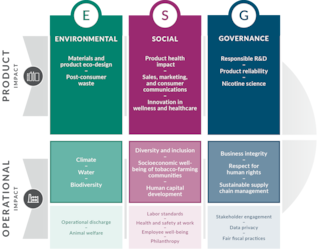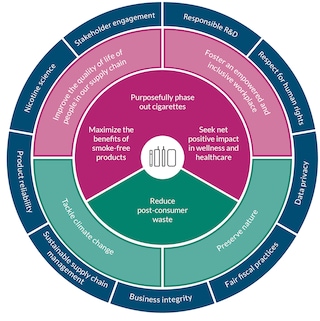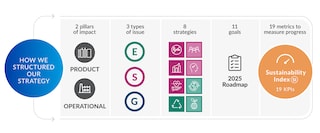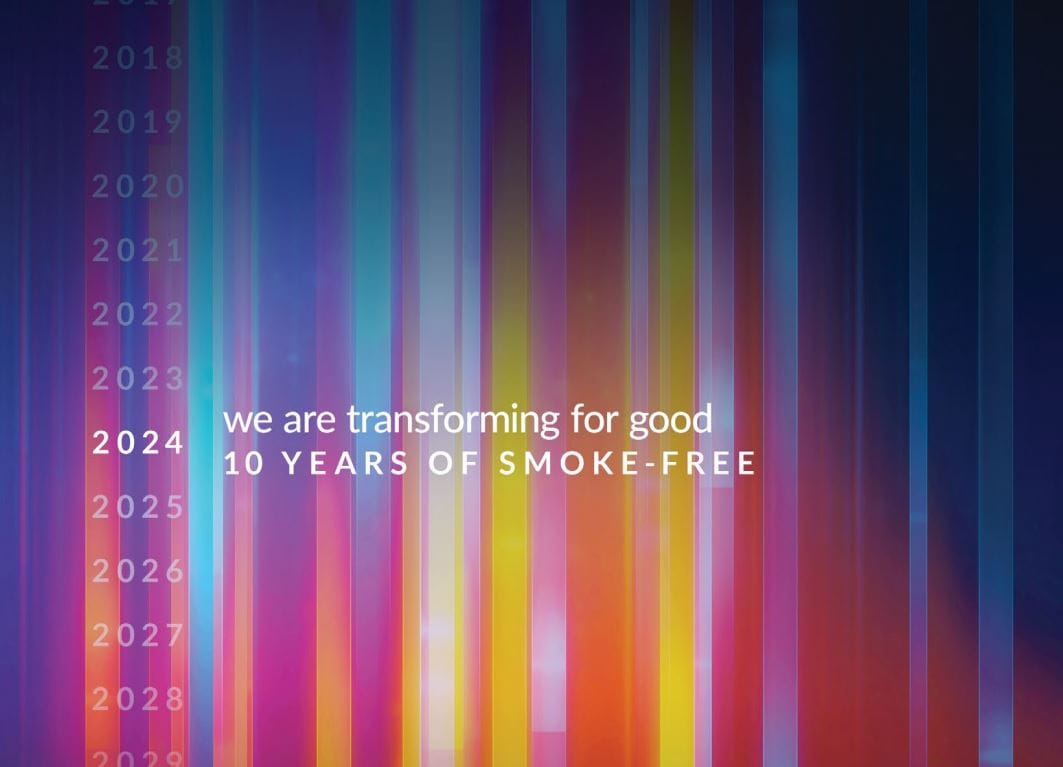We see sustainability as a fundamental opportunity for innovation, growth, and purpose-led, impact-driven, long-term value creation.
A new ESG framework
We redesigned our environmental, social, and governance (ESG) framework to better showcase the ESG topics we should focus on, and to prioritize our resources. This framework recognizes two distinct forms of issues: Those that relate to our products (what
we produce) which are part of the “Product Impact” pillar, and those related to our business operations (how we produce), which are part of the “Operational Impact” pillar. We subsequently classified each topic, based on its
environmental, social, or governance-related nature. We provide details on the methodology and results of our assessment, as well as on our updated ESG framework, in our Sustainability Materiality Assessment Report 2021.
A new sustainability strategy
Our approach to sustainability addresses our ESG priorities through eight impact-driven strategies. Four of these strategies focus on the impacts derived from our products, and four focus on the impacts derived from our business operations. Last, but not least, our strategy highlights the importance of governance-related topics, which cannot be overstated. Our company’s policies, rules, and procedures define our ability to implement sound strategies that successfully address environmental and social issues.
This strategy crystallizes the notion of these two distinct forms of social and environmental impacts—those generated by our products (what we produce) and those generated by our business operations (how we produce). This approach allows us to appropriately highlight that, consistent with our sustainability materiality analysis results, addressing the social impacts generated by our products is the core of our strategy.
The biggest and most pressing negative externality our strategy aims to address is the health impacts of cigarette smoking. This is the most important contribution we can make to public health, and is the cornerstone of PMI’s purpose and business strategy.
Addressing this critical issue requires a three-part approach:
- Develop better alternatives to smoking for adult smokers who would otherwise continue to smoke
Research, develop, and commercialize scientifically substantiated nicotine-containing products that are less harmful than cigarettes. - Accelerate smoking decline
Provide broad access to adult smokers, who otherwise would not quit smoking, to ensure these products accelerate the decline of smoking prevalence. - Make cigarettes obsolete
Purposefully work to ensure these products ultimately replace cigarettes, driving their obsolescence.
Our revised 2025 Roadmap
Our Roadmap outlines our key goals, and informs the route of our company’s long-term plan. PMI’s revised 2025 Roadmap comprises 11 headline goals, running to the end of 2025, connected to our eight strategies.
New PMI Sustainability Index
To link each goal to specific outcomes and impacts, we developed a set of key performance indicators (KPIs) that precisely articulate how to measure progress and define success. These 19 KPIs constitute our Sustainability Index. Covering the full spectrum of our sustainability priorities, the Index will allow PMI and our stakeholders to track the company’s progress toward its goals year-over-year.
To increase the robustness of our nonfinancial performance data and disclosures, we developed a consolidated set of nonfinancial standards: PMI’s ESG KPI Protocol. The Protocol includes the definition, methodology, and scope of each of our main ESG KPIs to ensure measurable, verifiable, consistent, and accurate reporting on progress. All KPIs included in the index are part of the ESG KPI Protocol.







